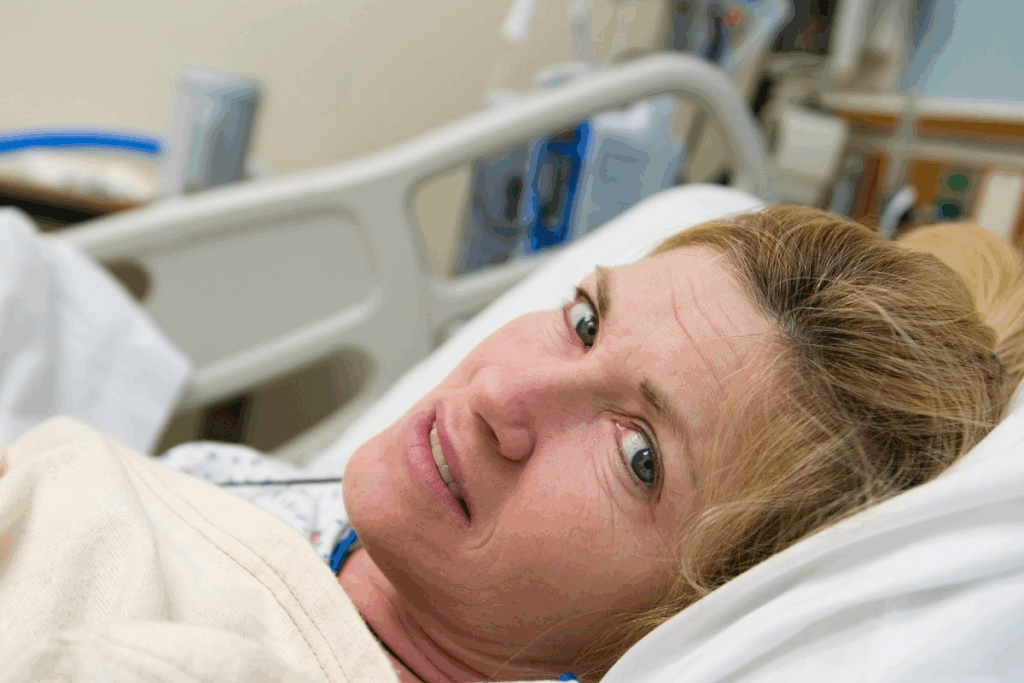
Recurrent urinary tract infections (UTIs) are a big problem for elderly women. They can really hurt their quality of life and make them less independent. The Medical organization says a UTI is considered recurrent if a woman has it two times in six months or three times in a year.Effective treatment strategies for recurrent UTI in elderly female patients, including prophylactic antibiotics and estrogen therapy.
About 20-30% of older women get UTIs again. This shows we really need to find good ways to manage these infections.
As we get older, our bodies change in ways that make UTIs more likely. Our guide looks at the best ways to treat and prevent UTIs in older women.
The Prevalence and Impact of Recurrent UTIs in Elderly Women

It’s important to know how common and impactful recurrent UTIs are in elderly women. These infections can really affect their quality of life and overall health.
Studies show that many women over 55 get UTIs again and again. In fact, 53% of women in this age group report a recurrent UTI within one year. This shows we need to focus on helping them more.
UTIs are common in older adults, with rates ranging from 20% to over 50% in those living in care homes. This big difference shows how important where someone lives is for UTI rates.
Population | UTI Prevalence |
Community-dwelling elderly | 20% |
Institutionalized elderly | >50% |
Recurrent UTIs can really hurt the health and life quality of elderly women. They can lead to serious problems like sepsis and kidney damage. They can also make it harder for people to function.
On top of that, dealing with these infections over and over can make people anxious and depressed. This makes their life even harder.
Understanding the impact of recurrent UTIs helps healthcare providers help elderly women more. This can improve their health and life quality a lot.
Physiological Changes Increasing UTI Risk in Older Women

As women get older, their bodies change in ways that make them more likely to get urinary tract infections (UTIs). Aging leads to many changes that raise the risk of UTIs in women. We will look at these changes and how they affect older women’s urinary health.
One big reason older women get more UTIs is the loss of estrogen. StatPearls says losing estrogen means fewer good bacteria in the vagina. This makes it easier for bad bacteria to grow and cause UTIs.
“Estrogen is key to keeping the urinary tract healthy,” studies show. When estrogen levels drop during menopause, the urinary tract changes. This makes it more likely to get infections.
As we age, our bladders don’t work as well. Older women may not empty their bladders fully. This lets bacteria grow and cause infections.
These bladder changes can lead to UTIs. Bacteria have an easier time growing when urine stays in the bladder.
Another big change with age is the weakening of the pelvic floor muscles. This can cause urinary incontinence. Incontinence not only affects quality of life but also raises UTI risk. It makes the genital area moist, perfect for bacteria to grow.
“The weakening of pelvic floor muscles is a common issue among older women, often resulting in urinary incontinence and increasing the risk of UTIs.”
It’s important to address these changes to prevent UTIs in older women. Knowing what increases UTI risk helps healthcare providers find better ways to prevent and treat them.
Common Pathogens Causing UTI in Elderly Female Patients
It’s key to know the main causes of UTIs in elderly women to treat them well. These infections are often due to certain bacteria. Knowing which ones are most common helps in managing the infections better.
Escherichia coli (E. coli) is the top cause of UTIs in elderly women, making up about 80% of cases. E. coli is a common gut bacteria that can easily move to the urinary tract. This shows why we need specific antibiotics for these infections.
While E. coli is the main culprit, other bacteria like Klebsiella pneumoniae, Proteus mirabilis, and Enterococcus species also play a big role. The NCBI Bookshelf says these cause more serious UTIs. They often need stronger antibiotics to treat.
Knowing about these bacteria is vital for treating UTIs in elderly women. By pinpointing the exact bacteria, doctors can give more targeted treatments. This helps in better managing and preventing future infections.
UTI symptoms in older women can be tricky to spot. This is because they can show up in different ways. As we get older, our bodies react to infections differently, making it harder to figure out what’s wrong.
UTIs often cause dysuria (pain when you pee), urgency (needing to pee right away), and frequency (needing to pee a lot). These happen because bacteria upset the bladder and urinary tract. This causes pain and changes how you pee.
In elderly women, UTIs can show up in less obvious ways. Some common signs include:
These signs can make it hard to spot UTIs right away. They might seem like other problems or just part of getting older.
It’s important to tell UTIs apart from other issues. Doctors need to think about other possible causes of symptoms. This includes:
Getting a correct diagnosis takes a few steps. Doctors use a mix of checking you over, lab tests, and sometimes pictures of your insides. Knowing how UTIs show up in older women helps doctors give better care.
Getting a correct diagnosis is key to treating recurrent UTIs. We will look at how to identify and manage these infections in elderly women.
Urinalysis and urine culture are key tools for diagnosing UTIs. Urinalysis checks the urine’s physical and chemical makeup for signs of infection. It looks for pyuria (pus) or hematuria (blood).
Urine culture helps find the infection’s cause and the right antibiotic. Together, these methods help diagnose UTIs and choose the right treatment.
Imaging is not usually needed for simple UTIs. But, it’s used for complicated cases or when the upper urinary tract is involved. Ultrasound and CT scans check for issues like stones or blockages.
We suggest imaging for symptoms like flank pain or fever. It helps find problems that cause recurring infections.
For complicated or recurring UTIs, more tests are needed. These include urodynamic studies for bladder function, cystoscopy to see inside the bladder, and voiding cystourethrograms to check emptying.
These tests help find the root cause of recurring UTIs. They help us create effective treatment plans.
Antibiotic Treatment Protocols for Recurrent UTI in Elderly Females
Managing recurrent urinary tract infections (UTIs) in elderly females is key. It’s important to understand antibiotic treatment well. This helps improve their quality of life.
Choosing the right antibiotic for elderly women with UTIs is complex. It depends on the bacteria causing the infection, any allergies, and local resistance. Nitrofurantoin and sulfamethoxazole-trimethoprim are often first choices because they work well against common UTI bacteria.
For simple UTIs, a short antibiotic course usually works. But for recurring infections, treatment might need to last longer or involve different approaches.
Antibiotic | Dosage | Duration |
Nitrofurantoin | 100 mg twice daily | 5-7 days |
Sulfamethoxazole-trimethoprim | 160/800 mg twice daily | 3-5 days |
Fosfomycin | 3 g single dose | 1 day |
Antibiotic resistance is a big problem in treating UTIs. When resistance is a concern, fosfomycin might be a better choice. It’s vital to keep an eye on local resistance and adjust treatments as needed.
Antibiotic stewardship is also critical. It means choosing the right antibiotic, dose, and length to reduce resistance risks.
For those with often recurring UTIs, suppressive therapy can be helpful. It involves using low-dose antibiotics regularly to prevent infections.
Options include taking antibiotics every night or every other night. The best choice depends on how well the patient can tolerate it, their kidney health, and local resistance.
We should always check if suppressive therapy is needed and adjust it as necessary. This helps avoid risks and ensures benefits.
Non-antibiotic strategies are great for stopping UTIs in older women. We need to think about how menopause changes the body and UTI risk.
Vaginal estrogen therapy is a good choice for fighting UTIs in postmenopausal women. StatPearls says it helps by making the vaginal area healthier and improving the environment around the bladder.
Benefits of Vaginal Estrogen Therapy:
Cranberry products and D-mannose might help prevent UTIs. Some studies show they could stop bacteria from sticking to the bladder wall.
Supplement | Potential Benefits | Evidence Level |
Cranberry Products | May reduce UTI incidence | Moderate |
D-Mannose | May prevent bacterial adhesion | Limited |
Probiotics, which help the vaginal microbiome, might prevent UTIs. They keep the vaginal flora balanced, stopping bad bacteria from growing too much.
The role of probiotics in UTI prevention is an area of ongoing research, with promising results.
Drinking enough water and making dietary changes can help manage UTIs. Water flushes out bacteria, and some foods might lower UTI risk.
Dietary Recommendations:
Preventive Measures for Chronic UTI in Elderly Women
To stop UTIs from coming back, elderly women need to make lifestyle changes and get medical help. Knowing and using the right prevention steps can lower their UTI risk a lot.
Keeping clean is key to avoiding UTIs. Wipe from front to back, keep the area clean, and avoid harsh soaps. Good hygiene is vital for UTI prevention.
The Medical organization says good hygiene is key to stop UTIs from coming back. Keeping the genital area clean and dry, after using the bathroom or sweating, helps a lot.
“Good hygiene is fundamental to preventing infections, including UTIs. Simple habits can make a significant difference.”
Bladder training helps you go longer without needing to pee. It’s great for elderly women with incontinence or who pee too often. It makes your bladder muscles stronger.
Some elderly women might need treatments to stop UTIs from coming back. This could be low-dose antibiotics or vaginal estrogen. These treatments can really cut down UTI recurrence.
Treatment Option | Description | Benefits |
Low-dose Antibiotic Therapy | Daily or post-coital antibiotics to prevent UTI | Reduces risk of recurrent UTIs |
Vaginal Estrogen Therapy | Estrogen replacement to improve vaginal health | Improves vaginal flora and reduces UTI risk |
By adding these prevention steps to their daily life, elderly women can lower their UTI risk. This improves their quality of life a lot.
Managing UTIs in institutionalized patients is a big challenge. These patients often have complex health issues and can’t move easily. This makes them more likely to get UTIs.
Proper catheter management is key to preventing UTIs in these patients. Care facilities use urinary catheters a lot, but they increase UTI risk.
Effective catheter management not only reduces UTI risk but also improves patient comfort and outcomes.
Staff education is vital for preventing and managing UTIs in care facilities. Healthcare workers need to know the best ways to care for catheters and prevent UTIs.
Education Topic | Description | Benefits |
Catheter Care Techniques | Proper insertion, maintenance, and removal of catheters | Reduces risk of UTIs |
UTI Recognition | Identifying symptoms of UTIs in elderly patients | Prompts timely intervention |
Hygiene Practices | Hand hygiene and proper use of personal protective equipment | Prevents spread of infections |
The environment in care facilities is also important for preventing UTIs. Keeping facilities clean and following infection control rules is essential.
Regular audits and feedback to staff on infection control practices can significantly reduce UTI incidence.
By focusing on catheter management, staff education, and environmental factors, care facilities can lower UTI rates. These efforts need a team effort and a dedication to constant improvement.
An integrated approach is key to managing recurrent UTIs in elderly females. We’ve talked about different strategies. These strategies, when used together, form a complete plan for treating and preventing UTIs.
Managing recurrent UTIs needs a plan that includes medical treatment, lifestyle changes, and prevention. The treatment for elderly females should fit their unique needs. This means considering their health, medical history, and personal preferences.
Healthcare providers can help elderly women by using an integrated approach. This approach includes antibiotic treatments, non-antibiotic strategies, and prevention methods. These include vaginal estrogen therapy, cranberry products, and probiotics.
We stress the need for teamwork between healthcare providers and patients. By working together, we can better manage recurrent UTIs. This improves the quality of life for elderly females.
Elderly women face several risks for UTIs. These include the loss of estrogen after menopause. Also, changes in bladder function and a weakened pelvic floor play a role. Certain health conditions, like diabetes, can also increase the risk.
Changes in older women can raise UTI risk. Estrogen loss, weaker bladder muscles, and a weakened pelvic floor change the urinary tract. These changes can make it harder for the body to fight off infections.
UTIs in elderly women often show up as painful urination, needing to urinate often, and feeling a strong need to urinate. They might also feel confused, agitated, or see a general decline in health.
Doctors use urinalysis and culture techniques to diagnose UTIs. They might also use imaging studies. This helps find the cause and check for any complications in the urinary tract.
The first choice for treating UTIs includes antibiotics like trimethoprim/sulfamethoxazole, nitrofurantoin, or fosfomycin. The right choice depends on local resistance, patient allergies, and the situation.
Yes, there are non-antibiotic ways to manage UTIs. These include vaginal estrogen therapy, cranberry products, probiotics, and staying hydrated. Making dietary changes can also help prevent UTIs.
Preventing chronic UTIs involves good hygiene, bladder training, and sometimes antibiotics. It’s also important to address underlying risk factors.
Managing UTIs in those living in institutions requires careful attention to catheter use and staff training. It’s also important to consider the environment and how it might affect UTI risk.
Yes, managing recurrent UTIs in elderly females is possible. A good plan includes the right antibiotics, non-antibiotic treatments, and prevention. This can greatly improve their quality of life.
Vaginal estrogen therapy helps by making the vaginal and urethral areas healthier. This improves the body’s defense against bacteria and infections.
Cranberry products might help by stopping bacteria from sticking to the bladder and urinary tract. But, their effectiveness can vary.
Yes, probiotics, like those that support the vaginal microbiome, can help prevent UTIs. They promote a healthy balance of microorganisms.
Drinking enough water and avoiding irritants like caffeine and spicy foods can help. These steps reduce bladder irritation and support urinary tract health.
Mandel, I., Dykstra, J., & Mandel, K. S. (2020). Urinalysis. In StatPearls. StatPearls Publishing. https://www.ncbi.nlm.nih.gov/books/NBK557685/
Subscribe to our e-newsletter to stay informed about the latest innovations in the world of health and exclusive offers!
WhatsApp us